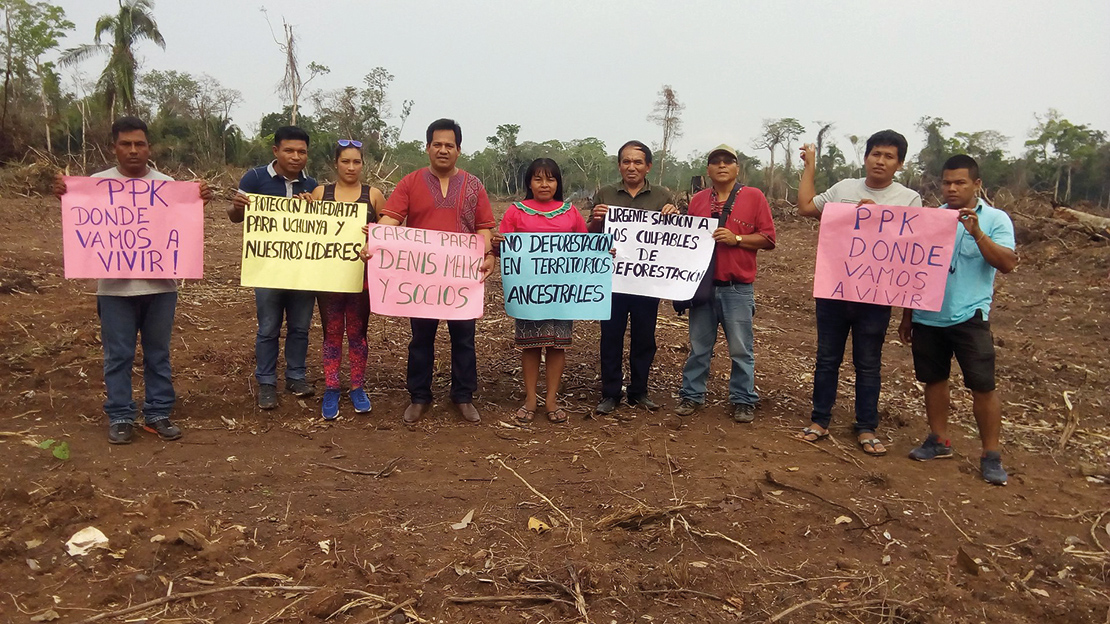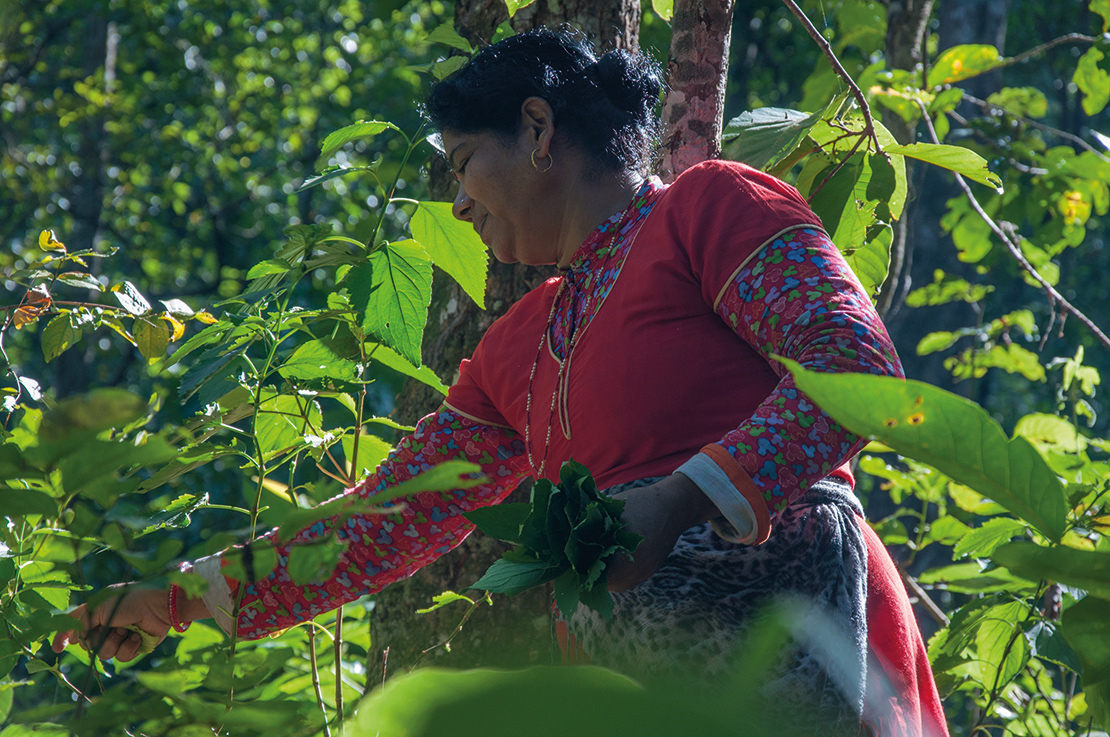
Target 4: Sustainable production and consumption
By 2020, at the latest, Governments, business and stakeholders at all levels have taken steps to achieve or have implemented plans for sustainable production and consumption and have kept the impacts of use of natural resources well within safe ecological limits.
Key messages
- Unsustainable global production and consumption systems continue to drive biodiversity loss and displace indigenous peoples and local communities (IPLCs).
- Voluntary standards, such as certification systems, are proving insufficient to bring about the transformative changes needed to ensure sustainable production and consumption.
- Small-scale local production systems contribute far more to global production than is generally realised. They are more sustainable, more resilient and more beneficial for local livelihoods and biodiversity than industrial production.
- Support for local sustainable production systems needs to be scaled up urgently, and community-led natural resource governance systems must be fully recognised and enabled.
Significance of Target 4 for IPLCs
Progress towards Target 4 has been limited.1 Since 1980, the consumption of materials per person has risen 15 per cent and over the past three decades global extraction of biomass, fossil fuels, minerals, and metals has risen by approximately 80 per cent.2 As a result, industrial agriculture and the extractive industries have expanded further into IPLC lands and territories, with serious ecological and social consequences, including loss of species and ecosystems; pollution of waterways; and widespread displacement and destitution involving severe human rights violations.3

Plantations and deforestation have a grave impact on the ways of life of nearby communities, who, despite these encroachments, often play a vital role in preserving biodiversity. This illustration depicts a patch of forest remaining after deforestation by fire, a method often used to clear land for plantations. Credit: Agnès Stienne, Dépaysages de palmiers à huile, Visionscarto.net.
Awareness of the dangers posed by unchecked production and consumption has come together into a dedicated target under the Sustainable Development Goals.4 Attention, however, has been focused largely on consumer choice and improving efficiency on a product-by-product basis rather than considering the systemic changes necessary to keep within safe ecological limits.5 In this context, the ecologically sensitive approaches of IPLCs to production and consumption, some of which are discussed in this chapter, are instructive. These approaches, however, have been insufficiently supported by governments and other actors with vested interests in maintaining the economic status quo or the resource extraction potential of IPLC lands and territories.6
Contributions and experiences of IPLCs towards Target 4
“The situation the Earth is in today has been created by unmindful production and unmindful consumption. We consume to forget our worries and our anxieties. Tranquilising ourselves with over-consumption is not the way.”
— Thich Nhat Hanh, spiritual leader, Vietnam
The widespread indigenous concept of buen vivir (living well in harmony with nature) is based on norms related to ecological and cultural balance that discourage overconsumption and underpins the small ecological footprints of many indigenous societies.7 IPLCs often promote genetic diversity in their local production systems in the form of traditional crop varieties and traditional livestock breeds8, often purposefully propagated by women or by men, which makes these systems much more resilient to pests and natural disasters. Customary sustainable use of wild resources is also a common part of land use planning and territorial management. And some IPLCs are striving to improve international commodity certification schemes such as the Forest Stewardship Council and voluntary supply chain initiatives, including for the purpose of greater accountability.
Local sustainable production
The scale of smallholder contributions to global production is often overlooked. When multiplier effects are taken into account, they account for 12–35 per cent of global economic output, or US$8.7–US$25.9 trillion per year.9 Moreover, when they are based on secure land rights and indigenous and local knowledge systems, local production systems provide far greater local social and economic benefits, and tend to be far more favourable to biodiversity, in comparison with mainstream models of production and consumption.10
A concerted shift towards supporting these kinds of systems to persist and spread would transform production systems towards greater sustainability.11
- Traditional coffee farms in the Sierra Norte de Puebla, Mexico, are reservoirs of biodiversity. They are also important sources of materials for handicrafts and local cuisine, which is promoted in inter-village food fairs organised by local youths.12
- Yanesha indigenous women in the central Amazonian region of Peru have been developing strategies to recover knowledge about natural dyes and native coloured cotton (bespan in Yanesha), which is strengthening their initiatives from a territorial management perspective and improving their artistic production of clothes and other items for commercial purposes within the fair-trade framework.
- The Botanical Products Association of Liberia supports better livelihoods for its members through the development of non-timber forest products, and facilitates members’ engagement in policy debates on sustainable forest management.13
- In response to the increasing promotion of agro-chemicals and the threat of expansion of agribusiness and industrial plantations, in 2016 the Alliance of the Indigenous Peoples of the Highlands self-declared the Krayan highlands in Borneo as an area for organic and traditional agriculture. In 2019, the Head of the Nunukan regency issued a decree for the preservation and development of the traditional agricultural practices, including the importance of agrobiodiversity of rice and other crops in the Krayan Highlands. This is a formal government recognition of this area as their ‘territory of life’.14
- The Māori in Aotearoa/New Zealand offer an example of local sustainable land management. Their regional tribal (iwi) environmental management plans bring together spiritual and natural resource concerns in overall environmental governance, and incorporate the concept of guardianship over the sky, the sea, the land and sacred places (kaitaikitanga).
International standards
“What do we mean by the term sustainability? The palm oil industry has not dealt with many of the past and present violations of community rights by agribusiness developments. It is not enough to create voluntary certification schemes, while we continue to suffer land grabs and the ongoing violation of human rights.”
— Franky Samperante, Pusaka, Indonesia
IPLCs have been working with civil society partners to limit the impacts on their lands of industrial agriculture, mining and hydrocarbon extraction through community-based environmental and social monitoring, advocacy, and representation on voluntary certification bodies, such as the Roundtable for Sustainable Palm Oil (RSPO). On paper, many such certification schemes have impressive requirements in relation to respect for human and indigenous rights and environmental and social impacts; however, their implementation commonly has serious shortcomings. For example, the RSPO requires companies to carry out land tenure assessments, assess high conservation values (including biodiversity, cultural and livelihoods values), and put in place integrated conservation and land use plans before clearing any land;15 however, in many cases these measures have been omitted and very few such plans have been developed. Most certification schemes are still top-down processes that marginalise IPLC perspectives and values.16
IPLCs are critical partners in monitoring certified operations on the ground and drawing attention to cases of non-compliance. However, companies who break the rules have in some cases simply withdrawn from certification to avoid penalties (see Box 7). Clearly, voluntary supply-chain initiatives alone are not enough to enact the changes needed to create sustainable production systems that conserve biodiversity and respect the rights of IPLCs.

In September 2019, leaders from Santa Clara de Uchunya and FECONAU with legal support from IDL took their land rights struggle before Peru’s highest court, the Constitutional Tribunal. Credit: FECONAU.
Box 7: Shipibo-Conibo people defend their territories from palm oil in the Peruvian Amazon
Protest again palm oil. Credit: FECONAU.

Case study: Federación de Comunidades Nativas del Ucayali y Afluentes and Forest Peoples Programme
The traditional lands of the Shipibo-Conibo indigenous community of Santa Clara de Uchunya in the Peruvian Amazon extend to more than 85,000 hectares. Historically, these lands have provided abundant game and fish, medicines, construction materials and clean water. However, only 218 hectares have been formally titled.
— Read the full case study

Gathering medicinal plants from a community-managed forest near Hetauda, Nepal. Credit: Claire Bracegirdle.

Women from Aldea Campur, in Alta Verapaz, make, market and package their own shampoo. Credit: UN Women/Ryan Brown.
Opportunities and recommended actions
- IPLCs should maintain, strengthen and expand their modes of sustainable production and consumption.
- Governments and relevant actors should support IPLCs to develop, implement and scale up local sustainable modes of production and management, based on secure collective land rights.
- Governments and relevant actors should ensure that all supply-chain actors are subject to, and adhere to, clear human-rights and environmental regulation, with clear mechanisms for access by IPLCs, including to accountability mechanisms and complaints processes.
- Governments and relevant actors should facilitate inclusion of IPLC knowledge and experience in establishing the policy framework for sustainable production and consumption in the overall strategy towards the 2050 vision of “living in harmony with nature”, encompassing SDG 12 and other relevant international policy guidance.17
Key resources
- Anderson, C., Bruil, J., Chappell, M. J., Kiss, C. and Pimbert, M. P. (2019) ‘From transition to domains of transformation: Getting to sustainable and just food systems through agroecology’, Sustainability 11(19).
- FAO (2019) The state of the world’s biodiversity for food and agriculture. Bélanger, J and D. Pilling (Editors). Rome: FAO Commission on Genetic Resources for Food and Agriculture Assessments. Available at: http://www.fao.org/3/CA3129EN/ca3129en.pdf
References
- IPBES (2019) Summary for policymakers of the global assessment on biodiversity and ecosystem services of the Intergovernmental Science-Policy Platform on Biodiversity and Ecosystem Services. S. Díaz, J. Settele, E. S. Brondízio E.S., H. T. Ngo, M. Guèze, J. Agard, A. Arneth, P. Balvanera, K. A. Brauman, S. H. M. Butchart, K. M. A. Chan, L. A. Garibaldi, K. Ichii, J. Liu, S. M. Subramanian, G. F. Midgley, P. Miloslavich, Z. Molnár, D. Obura, A. Pfaff, S. Polasky, A. Purvis, J. Razzaque, B. Reyers, R. Roy Chowdhury, Y. J. Shin, I. J. Visseren-Hamakers, K. J. Willis, and C. N. Zayas (eds.). Bonn, Germany: IPBES. Available at: https://doi.org/10.5281/zenodo.3553579
- Balvanera, P. and Pfaff, A. (2019) ‘Chapter 2: Status and trends; Indirect and direct drivers of change’. In: IPBES Global Assessment on Biodiversity and Ecosystem Services. Bonn: IPBES. Available at: https://ipbes.net/global-assessment
- Forline, L. (2015) ‘The Awá-Guajá and Brazil’s expanding frontier In Amazonia’, Urban Anthropology and Studies of Cultural Systems and World Economic Development 44(3/4), pp. 293-329.
—
Martone, F. (2019) Enough! Pledging zero tolerance to attacks against environmental and human rights defenders. Moreton-in-Marsh: Forest Peoples Programme. Available at: https://www.forestpeoples.org/en/lands-forests-territories/report/2019/enough-pledging-zero-tolerance-attacks-against-environmental -
IPBES (2019) Summary for policymakers of the global assessment on biodiversity and ecosystem services of the Intergovernmental Science-Policy Platform on Biodiversity and Ecosystem Services. S. Díaz, J. Settele, E. S. Brondízio E.S., H. T. Ngo, M. Guèze, J. Agard, A. Arneth, P. Balvanera, K. A. Brauman, S. H. M. Butchart, K. M. A. Chan, L. A. Garibaldi, K. Ichii, J. Liu, S. M. Subramanian, G. F. Midgley, P. Miloslavich, Z. Molnár, D. Obura, A. Pfaff, S. Polasky, A. Purvis, J. Razzaque, B. Reyers, R. Roy Chowdhury, Y. J. Shin, I. J. Visseren-Hamakers, K. J. Willis, and C. N. Zayas (eds.). Bonn, Germany: IPBES. Available at: https://doi.org/10.5281/zenodo.3553579
—
UNEP (2019) Ministerial Declaration of the United Nations Environment Assembly at Its Fourth Session Innovative Solutions for Environmental Challenges and Sustainable Consumption and Production. UNEP/EA.4/HLS.1. UNEP. - Geels, F. W., McMeekin, A., Mylan, J. and Southerton, D. ‘A critical appraisal of sustainable consumption and production research: The reformist, revolutionary and reconfiguration positions’, Global Environmental Change (34), pp. 1-12.
—
Bengtsson, M., Alfredsson, E., Cohen, M., Lorek, S. and Schroeder, P. (2018) ‘Transforming systems of consumption and production for achieving the sustainable development goals: Moving beyond efficiency’. Sustainability Science (13). - Fa, J. E. et al. (2020) ‘Importance of Indigenous Peoples’ lands for the conservation of intact forest landscapes’. Frontiers in Ecology and the Environment. 18(3), pp. 135-140.
- Balch, O. (2013) ‘Buen vivir: The social philosophy inspiring movements in South America’. The Guardian. London: The Guardian. Available at: https://www.theguardian.com/sustainable-business/blog/buen-vivir-philosophy-south-america-eduardo-gudynas
- FAO (2019) The state of the world’s biodiversity for food and agriculture. J. Bélanger, and D. Pilling (Eds). Rome: FAO Commission on Genetic Resources for Food and Agriculture Assessments. Available at: http://www.fao.org/3/CA3129EN/ca3129en.pdf
- Verdone, M. (2018) The world’s largest private sector? Recognising the cumulative economic value of small-scale forest and farm producers. Report. Gland: IUCN, FAO, IIED. Available at: https://portals.iucn.org/library/node/47738
- Kansanga, M. M., Luginaah, I., Bezner Kerr, R., Lupafya, E. and Dakishoni, L. (2020) ‘Beyond ecological synergies: examining the impact of participatory agroecology on social capital in smallholder farming communities’, International Journal of Sustainable Development & World Ecology 27(1), pp. 1-14.
—
Hilmi, A. (2018) Agroecology: Reweaving a new landscape. London: Palgrave Macmillan. - Anderson, C., Bruil, J., Chappell, M. J., Kiss, C. and Pimbert, M. P. (2019) ‘From transition to domains of transformation: Getting to sustainable and just food systems through agroecology’, Sustainability 11(19).
- Toledo, V. M. and Moguel, P. (2012) ‘Coffee and sustainability: The multiple values of traditional shaded coffee’, Journal of Sustainable Agriculture 36(3), pp. 353-377.
—
Potvin, C., Owen C. T., Melzi, S. and Beaucauge, P. (2005) ‘Biodiversity and modernization in four coffee-producing villages of Mexico’, Ecology and Society 10(1). - Grouwels (2018) Forest and Farm Facility Country Achievements: Liberia. Food and Agriculture Organization of the United Nations.
- Pimbert, M. P. and Borrini-Feyerabend, G. (2019) Nourishing life – territories of life and food sovereignty. Policy brief of the ICCA Consortium no. 6. Various: ICCA Consortium, Centre for Agroecology, Water and Resilience at Coventry University and CENESTA.
- Roundtable for Sustainable Palm Oil (n.d.) RSPO certification. Kuala Lumpur: Roundtable for Sustainable Palm Oil. Available at: https://rspo.org/certification
- Graber, C.B. (2011) ‘Indigenous cultural heritage and Fairtrade: Voluntary certification standards in the light of WIPO and WTO law and policymaking’, Prometheus: Critical Studies in Innovation 29(3), pp. 287-308.
—
McCarthy, J.F. (2012) ‘Certifying in contested spaces: Private regulation in Indonesian forestry and palm oil’, Third World Quarterly 33(10), pp. 1871-1888. - UNEP (2019) Ministerial Declaration of the United Nations Environment Assembly at Its Fourth Session Innovative Solutions for Environmental Challenges and Sustainable Consumption and Production. UNEP/EA.4/HLS.1. UNEP.


